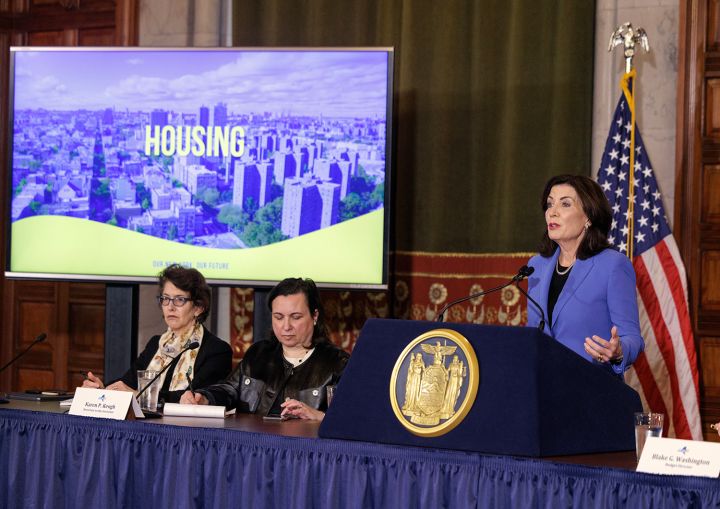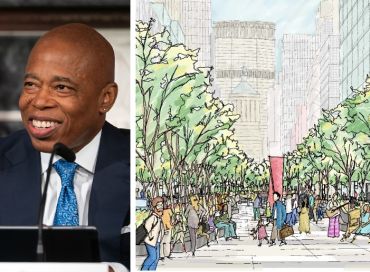New York Reaches ‘Conceptual Agreement’ for $237B State Budget
Framework includes a replacement for the 421a tax break and money to increase housing construction in the state
By Nick Trombola and Abigail Nehring April 15, 2024 6:17 pm
reprints
New York finally has a framework for a state budget deal, or “parameters for a conceptual agreement” at least, Gov. Kathy Hochul announced Monday evening.
Hochul emerged from closed-door budget negotiations Monday, 15 days past the deadline, to announce a preliminary agreement with state lawmakers for a $237 billion state budget and “a transformative deal to reverse the downward spiral on housing stock.”
That deal includes a potential replacement for a tax abatement to incentivize mixed-income housing development, funds to help combat retail theft, and a provision that will allow the development of residential properties on state-owned land. The “conceptual agreement” still needs full approval from the New York Assembly and Senate before it make its way to Hochul’s desk for her signature.
“We’ve reached an agreement that will make this happen and extend protections to tenants in New York that have never been available before,” Hochul said in a press conference. “These new measures represent the most comprehensive new housing policy our state has seen in three generations. This is a landmark deal, and I’m really proud of it.”
The tentative deal would increase spending from the $233 billion executive budget Hochul unveiled earlier this year, but falls short of the $245.8 billion spending plan the Assembly proposed last month.
It would increase state spending from last year’s inflation-adjusted $235.8 billion budget.
It has a blueprint for the future of housing in New York, the issue debated most contentiously in Albany and one which has largely delayed the talks. The agreement features incentives for building new housing, including a six-year extension of the expired 421a tax credit for buildings that include a certain percentage of affordable units, along with a replacement program for 421a, dubbed 485x.
A spokesperson for Hochul did not immediately provide more information on the 485x tax abatement.
The proposal also adds a $500 million investment to develop 15,000 units on state-owned sites such as former prisons.
Hochul was short on details on the housing component, saying only that a major package of legislation was in the works that would include a compromise on “good cause” tenant protections, a plan to eliminate the 1960s-era cap on the density of residential properties, and a path for landlords to convert office buildings to residential apartments.
That won praise from SL Green Realty CEO Marc Holliday, who said in a statement that “by incentivizing the conversion of underutilized and obsolete office space to housing, this vital legislation will uniquely address three of New York’s most pressing challenges.”
However, not everybody in real estate was as thrilled as Holliday about the proposed spending plan. Even with the scant details on 485x, James Whelan, president of the Real Estate Board of New York, warned it would not produce as much housing as its predecessor, 421a, which state lawmakers allowed to expire two years ago.
“The minor changes to the rules governing rent-regulated units will fail to reverse the declining quality of that housing stock,” Whelan said. “And while there were several modifications to the original legislation, good cause eviction will still create significant new risks for owners, developers and funders.
“We are confident that this package falls far short of addressing the city’s housing needs and must be reassessed in the coming years to put the rental housing market on a solid footing,” Whelan added.
Housing advocates, for their part, vociferously rejected the housing deal as rumors about rollbacks to the state’s 2019 landmark tenant protection bill and watered-down version of “good cause” tenant protections leaked out of Albany over the weekend. Protestors interrupted a state Assembly closed-door conference Monday to call for lawmakers to reject the deal.
Cea Weaver, the executive director of Housing Justice for All, labeled Hochul’s proposal a “sham of a housing deal” in a statement on Monday, and the nonprofit group released an analysis of the amended “good cause” bill concluding that it would fail to protect some 2.8 million tenants.
“Governor Hochul is pushing through a housing deal written by the real estate industry to ensure they keep getting richer off the back of hardworking tenants,” Weaver said.
New York City Mayor Eric Adams had a rosier outlook, calling the deal “a win for New Yorkers” and saying in a statement that it addressed his core priorities on housing, illegal smoke shop enforcement, and $2.4 billion for local migrant support.
The proposed budget adds $500 million more than the state gave last year to address the burgeoning migrant crisis in New York City, according to Hochul.
Criminal justice reforms were also high on Hochul’s list. Her “conceptual agreement” includes $347 million for expanded gun violence reduction programs, $40 million for coordination between law enforcement agencies, money to hire 100 new state troopers to crack down on smash-and-grab retail theft, and money to target illegal cannabis shops in New York City, which have cropped up by the hundreds in recent years.
And Hochul said the deal includes $40.2 million to support retail theft enforcement and increases penalties for shoplifters who assault retail workers in the process. Organized retail theft has become a frequent talking point for the governor, though there’s limited evidence of a real increase in the phenomenon.
Nick Trombola can be reached at ntrombola@commercialobserver.com. Abigail Nehring can be reached at anehring@commercialobserver.com.


